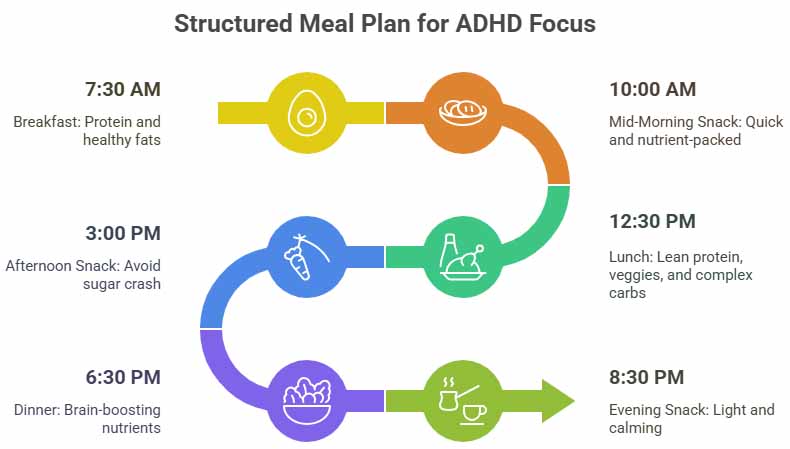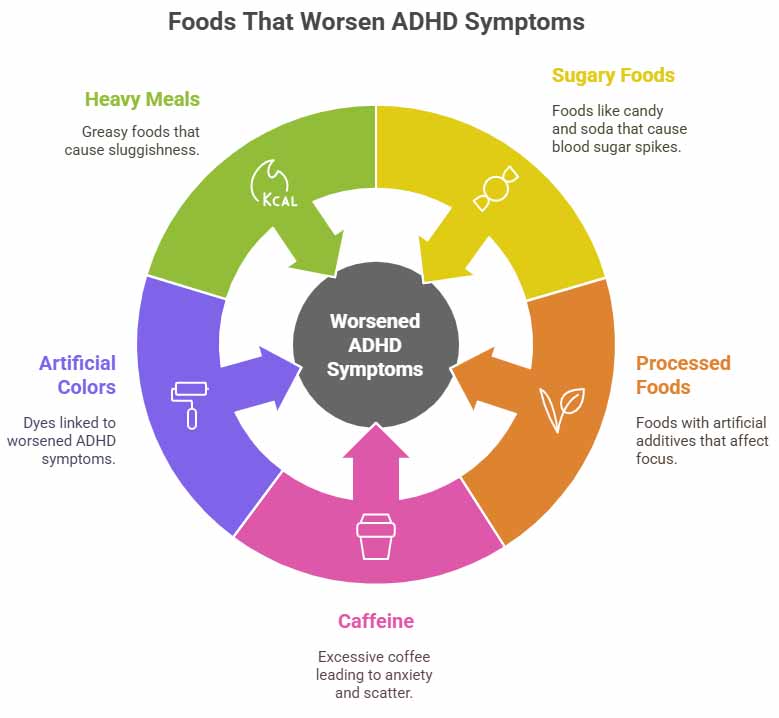The famous saying, “You are what you eat,” often pops up in conversations about health, but what if it held a deeper truth for adults living with ADHD? Picture this: a busy morning, a scattered mind, and a cup of coffee that just isn’t cutting it. For millions of adults with Attention Deficit Hyperactivity Disorder, this is a daily reality. But here’s interesting twist research suggests that what you put on your plate might help calm the chaos in your brain. Living with ADHD as an adult often means juggling a whirlwind of thoughts, distractions, and energy spikes. While medication and therapy are common go-tos, more people are asking: Can diet make a difference? The answer isn’t a magic fix, but it’s a promising yes.
Meal Plans for ADHD Adults

Creating a meal plan for ADHD adults isn’t about strict rules or boring routines. It’s about building habits that support your brain and body. The key? Consistency and balance. ADHD brains thrive on structure, and regular meals can help stabilize energy and focus. Here’s a simple daily plan to try:
- Breakfast (7:30 AM): Start with protein and healthy fats to kickstart your focus. Think scrambled eggs with avocado on whole-grain toast or a smoothie with Greek yogurt, berries, and a spoonful of almond butter.
- Mid-Morning Snack (10:00 AM): Keep it quick and nutrient-packed—handful of walnuts or an apple with peanut butter.
- Lunch (12:30 PM): Aim for a mix of lean protein, veggies, and complex carbs. A grilled chicken salad with quinoa and olive oil dressing works wonders.
- Afternoon Snack (3:00 PM): Avoid the sugar crash with something like hummus and carrot sticks or a few squares of dark chocolate.
- Dinner (6:30 PM): Wind down with salmon, sweet potato, and steamed broccoli—full of brain-boosting nutrients.
- Evening Snack (8:30 PM, if needed): A small bowl of plain popcorn or herbal tea with a handful of almonds.
The trick is to eat every 3-4 hours. This keeps blood sugar steady, which is a big deal for ADHD adults who might feel foggy or irritable when levels dip.
Foods That Help With ADHD
Certain foods have been shown to positively impact brain health and may alleviate some ADHD symptoms. These include:

- Omega-3 Fatty Acids: Found in fish like salmon, sardines, and tuna, as well as plant-based sources like walnuts and chia seeds, omega-3s are essential for brain function. Studies suggest they may help improve attention and reduce hyperactivity.
- Protein-Rich Foods: Protein provides the building blocks for neurotransmitters, the chemicals in your brain responsible for communication. Lean meats, beans, lentils, and tofu are excellent choices.
- Complex Carbohydrates: Whole grains like oats, barley, and brown rice release glucose slowly, providing steady energy without the crash associated with refined carbs.
- Iron-Rich Foods: Low iron levels have been linked to increased ADHD symptoms. Include spinach, red meat, and fortified cereals in your diet to boost iron intake.
- Magnesium and Zinc: Both minerals play a role in regulating dopamine, a neurotransmitter involved in focus and motivation. Almonds, pumpkin seeds, and dark chocolate are great sources.
- Antioxidant-Rich Foods: Berries, green tea, and colorful vegetables fight inflammation and oxidative stress, promoting better brain health.
Foods to Avoid with ADHD
Just as some foods help, others can make ADHD symptoms worse. They might trigger restlessness, mood swings, or that dreaded brain fog. Here’s what to steer clear of:

- Sugary Foods and Drinks: Candy, soda, and pastries send your blood sugar on a wild ride, leaving you jittery then wiped out. Skip the sugar highs—they’re not worth it.
- Processed Foods: Chips, fast food, and frozen meals often hide artificial additives and unhealthy fats that can mess with focus and energy.
- Too Much Caffeine: A little coffee might help, but too much can leave you anxious and scattered. Stick to one or two cups, max.
- Artificial Colors and Preservatives: Some studies link these (like Red Dye #40) to worse ADHD symptoms in sensitive people. Check labels on packaged snacks.
- Heavy, Greasy Meals: Think fried foods or massive burgers—they can slow you down and make you feel sluggish when you need clarity.
Recipes for an ADHD Diet Plan (With Full Details)
Berry Banana Smoothie
This smoothie is a quick and refreshing way to start your day or refuel during a mid-afternoon slump. Packed with antioxidants from berries, potassium from bananas, and omega-3s from chia seeds, it’s both nourishing and energizing.
Ingredients:
- 1 banana
- ½ cup mixed berries (blueberries, strawberries, raspberries)
- 1 tablespoon chia seeds
- 1 cup unsweetened almond milk
- 1 scoop vanilla protein powder (optional)
Instructions:
Blend all ingredients until smooth. Serve chilled for a refreshing breakfast or snack packed with antioxidants and protein.
Time & Temperature:
- Prep Time: 5 minutes
- Cooking Time: None (no heat required)
Equipment Needed:
- Blender
- Measuring cups and spoons
- Glass or jar for serving
Nutritional Information (per serving):
Calories: ~200 kcal | Protein: 8g | Carbs: 30g | Fat: 6g | Fiber: 7g
Substitutions:
- Swap almond milk for oat milk, coconut milk, or regular milk if preferred.
- Use hemp seeds or flaxseeds instead of chia seeds.
- Skip the protein powder or replace it with Greek yogurt for added creaminess and protein.
Grilled Salmon with Quinoa Salad
This dish combines lean protein from salmon with the fiber-rich goodness of quinoa and fresh vegetables. It’s light yet satisfying, making it perfect for lunch or dinner. The omega-3 fatty acids in salmon support brain health, while the quinoa provides sustained energy.
Ingredients:
- 1 salmon fillet (about 6 oz)
- ½ cup cooked quinoa
- 1 cup chopped cucumber, cherry tomatoes, and bell peppers
- Juice of ½ lemon
- 1 tablespoon olive oil
- Salt and pepper to taste
Instructions:
- Preheat your grill or stovetop grill pan to medium-high heat (about 375°F/190°C).
- Season the salmon with lemon juice, olive oil, salt, and pepper. Grill for 8–10 minutes, flipping halfway through, until the fish flakes easily with a fork.
- In a bowl, toss the cooked quinoa with chopped veggies. Drizzle with olive oil and season with salt and pepper.
- Serve the grilled salmon alongside the quinoa salad.
Time & Temperature:
- Prep Time: 10 minutes
- Cooking Time: 10 minutes
- Temperature: Medium-high heat (375°F/190°C)
Equipment Needed:
- Grill or grill pan
- Mixing bowls
- Knife and cutting board
- Tongs for flipping salmon
Nutritional Information (per serving):
Calories: ~400 kcal | Protein: 30g | Carbs: 25g | Fat: 20g | Fiber: 5g
Substitutions:
- Replace salmon with grilled chicken breast or tofu for a vegetarian option.
- Use brown rice or farro instead of quinoa.
- Add avocado slices to the salad for extra healthy fats.
Trail Mix Energy Bites
These no-bake energy bites are perfect for busy days when you need a quick snack to keep you going. They’re made with wholesome ingredients like oats, almond butter, and dark chocolate chips, offering a balance of carbs, protein, and healthy fats.
Ingredients:
- 1 cup rolled oats
- ½ cup almond butter
- ¼ cup honey
- ¼ cup dark chocolate chips
- 2 tablespoons flaxseeds
Instructions:
- In a mixing bowl, combine all ingredients until evenly distributed.
- Roll the mixture into bite-sized balls (about 1-inch diameter).
- Place the balls on a plate or baking sheet and refrigerate for at least 30 minutes to firm up.
- Store in an airtight container in the fridge for up to one week.
Time & Temperature:
- Prep Time: 10 minutes
- Chilling Time: 30 minutes
- No cooking temperature required
Equipment Needed:
- Mixing bowl
- Measuring cups and spoons
- Plate or baking sheet
- Refrigerator
Nutritional Information (per bite):
Calories: ~100 kcal | Protein: 3g | Carbs: 10g | Fat: 6g | Fiber: 2g
Substitutions:
- Use peanut butter or sunflower seed butter instead of almond butter.
- Substitute maple syrup or agave nectar for honey.
- Replace dark chocolate chips with cacao nibs or dried fruit like raisins or cranberries.
FAQs
Why is it so hard to eat with ADHD?
Eating can be challenging due to difficulties with executive function, which affects planning, organization, and focus. Meal prep, grocery shopping, and cooking can feel overwhelming. Impulsivity may lead to unhealthy food choices or skipping meals, while sensory sensitivities can make certain foods unappealing. Forgetting to eat or hyperfocusing on other tasks can also disrupt eating habits.
Does fasting help ADHD?
There’s no clear scientific evidence that fasting improves ADHD symptoms. Some report better focus during fasting, but effects vary. Since ADHD can make eating routines difficult, fasting may not be suitable for everyone. Consult a healthcare professional before trying fasting.
What drinks help ADHD?
- Water: Essential for hydration and health.
- Caffeine (e.g., coffee, tea): May improve focus for some, but effects vary.
- Herbal teas or protein smoothies: Can be beneficial for some individuals.
What is the relationship between ADHD and sugar?
The relationship is complex. Some studies suggest sugar might increase hyperactivity in certain individuals, but evidence is inconclusive. Sugar can affect mood and energy, potentially impacting ADHD symptoms indirectly. However, sugar does not cause ADHD, and effects vary by person.

